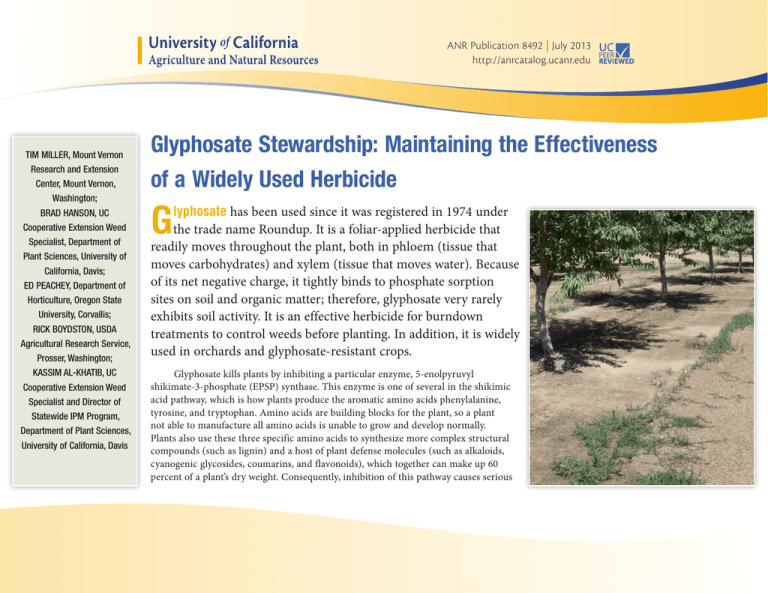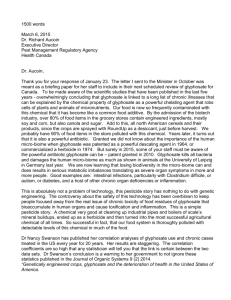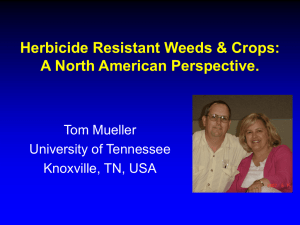
ANR Publication 8492 | July 2013
http://anrcatalog.ucanr.edu
TIM MILLER, Mount Vernon
Research and Extension
Center, Mount Vernon,
Washington;
BRAD HANSON, UC
Cooperative Extension Weed
Specialist, Department of
Plant Sciences, University of
California, Davis;
ED PEACHEY, Department of
Horticulture, Oregon State
University, Corvallis;
RICK BOYDSTON, USDA
Agricultural Research Service,
Prosser, Washington;
KASSIM AL-KHATIB, UC
Cooperative Extension Weed
Specialist and Director of
Statewide IPM Program,
Department of Plant Sciences,
University of California, Davis
Glyphosate Stewardship: Maintaining the Effectiveness
of a Widely Used Herbicide
G
lyphosate has been used since it was registered in 1974 under
the trade name Roundup. It is a foliar-applied herbicide that
readily moves throughout the plant, both in phloem (tissue that
moves carbohydrates) and xylem (tissue that moves water). Because
of its net negative charge, it tightly binds to phosphate sorption
sites on soil and organic matter; therefore, glyphosate very rarely
exhibits soil activity. It is an effective herbicide for burndown
treatments to control weeds before planting. In addition, it is widely
used in orchards and glyphosate-resistant crops.
Glyphosate kills plants by inhibiting a particular enzyme, 5-enolpyruvyl
shikimate-3-phosphate (EPSP) synthase. This enzyme is one of several in the shikimic
acid pathway, which is how plants produce the aromatic amino acids phenylalanine,
tyrosine, and tryptophan. Amino acids are building blocks for the plant, so a plant
not able to manufacture all amino acids is unable to grow and develop normally.
Plants also use these three specific amino acids to synthesize more complex structural
compounds (such as lignin) and a host of plant defense molecules (such as alkaloids,
cyanogenic glycosides, coumarins, and flavonoids), which together can make up 60
percent of a plant’s dry weight. Consequently, inhibition of this pathway causes serious
ANR Publication 8492 | Glyphosate Stewardship | July 2013 | 2
consequences for a plant, and it helps to explain why glyphosate is
such an effective herbicide. It is also an herbicide with a very low
mammalian toxicity, as mammals do not have the EPSP synthase
enzyme.
Table 1. Glyphosate product comparisons
Trade name
Roundup Original
Formulated
salt*
IPA
Concentration†
lb a.i./gal
lb a.e./gal
0.75 lb a.e. product
rate (oz/ac)
4
3
32
Using Glyphosate Effectively
Roundup Original Max
K
5.5
4.5
22
While glyphosate effectively controls many weedy species,
including annual and perennial grass and broadleaf weeds, many
factors play a role in how well it controls these weeds.
Roundup PowerMax
K
5.5
4.5
22
4
3
32
5.5
4.5
22
Formulation
Glyphosate is normally formulated as a salt, which is a compound
that can split into positively and negatively charged portions
when mixed with water. Glyphosate salts include potassium,
diammonium, isopropylamine, trimethylsulfonium, and
sesquisodium. Formulations differ in how much glyphosate ends
up in the final product, due to the chemistry of the salt and the
different adjuvants used by the various manufacturers. The amount
of the glyphosate salt in the formulation is listed on the herbicide
label as the active ingredient (a.i.). In the case of glyphosate,
however, only the glyphosate portion of the salt is actually
herbicidal; the other portion of the salt is nonherbicidal. Why
would a manufacturer formulate glyphosate as a salt? Glyphosate
salts are better able to enter into plant tissues than is the free
glyphosate acid, so these formulations provide better weed control.
Since different salts have different molecular weights, it
would be difficult to determine how much actual glyphosate is
contained in different formulated products if we just look at the
a.i. content, usually listed as pounds of a.i. per gallon (lbs a.i./
gal) or grams of a.i. per liter (g a.i./l). When comparing different
formulations of glyphosate, it is better to look at the acid equivalent
(a.e.), which is the amount of glyphosate in the negatively charged
or acid portion of the salt, the part of the a.i. that binds with EPSP
synthase. Therefore, using the a.e. is also the best way to select the
appropriate application rate for various formulations, since the a.e.
Roundup Ultra
Roundup WeatherMax
Touchdown
Touchdown Total
Touchdown HiTech
IPA
K
DA
3.75
3
32
K
5
4.2
24
K
6
5
19
Durango
IPA
5.4
4
26
Glyphomax XRT
IPA
5.4
4
26
most generics
IPA
4
3
32
Source: Peterson, D., B. Olson, K. Al-Khatib, R. Currie, J. A. Dille, J. Falk, P. Geier et al. 2007.
Glyphosate stewardship. Kansas State University publication MF-2767, Kansas State Research
and Extension website, http://www.ksre.k-state.edu/bookstore/pubs/MF2767.pdf.
Notes:
*Glyphosate is generally formulated as one of the following salt molecules:
IPA = isopropylamine; K = potassium; or DA = diammonium.
†The concentration of glyphosate salts can be expressed in terms of pounds of glyphosate
salt (a.i.) per gallon or pounds of glyphosate acid equivalent (a.e.) per gallon. Because
the various salts have different molecular weights, comparing glyphosate on an a.e. basis
provides a better comparison of the herbicidal component of the different salts.
represents the amount of glyphosate needed to control certain weed
species (table 1).
Adjuvants
Adjuvants are products mixed with a formulated herbicide to improve
its performance. Surfactants are the most commonly used adjuvants;
they modify the surface tension of water and, when in mixture
with an herbicide, cause applied droplets to spread out on leaves
ANR Publication 8492 | Glyphosate Stewardship | July 2013 | 3
and improve herbicide uptake. Most agricultural surfactants are
nonionic, although crop oils are also widely used; other surfactants
are organosilicon based. Most glyphosate formulations contain an
adequate concentration of surfactant for general use, so additional
surfactant is usually not necessary. Exceptions occur when applying
glyphosate to weeds with dense hairs or thick cuticles on their
leaves or when using a formulation that does not contain added
surfactant, such as aquatic formulations of glyphosate. Read the label
to determine whether adding a surfactant to a particular glyphosate
formulation, or for a particular weed species, is necessary.
Water-conditioning agents are another major type of adjuvant.
Because glyphosate can exist as a negatively charged molecule
after the herbicide is mixed with water, it can react with positively
charged ions (also called cations) or molecules in the water. Water
containing a high concentration of cations is commonly called hard
water. Some common cations in hard water include sodium (Na+),
potassium (K+), calcium (Ca2+), magnesium (Mg2+), and iron (Fe2+
or Fe3+). Cations with more than one positive charge bind strongly
to glyphosate and reduce its ability to be absorbed into plant leaves.
Water conditioners, such as ammonium sulfate (AMS) or
other proprietary adjuvants, help to soften hard water. When AMS
is added to water, the compound splits into two ammonium ions
+
(NH4 ) and one sulfate ion (SO42-). This ionized AMS helps improve
glyphosate performance in two ways. First, if glyphosate binds to
ammonium, the resultant molecule is much more easily absorbed
through the leaf cuticle, through the cell wall, or across the plasma
membrane of certain weed species than when glyphosate is bound
to other cations, resulting in more herbicide penetrating the weed.
Second, sulfate preferentially binds to calcium, magnesium, and
iron cations in the water, thus removing them from the solution
and leaving more glyphosate free to move into the weed. Studies
show that translocation of glyphosate is increased when AMS is
added, due to improved phloem mobility, probably because more
glyphosate in plant cells increases phloem loading and translocation
of the herbicide in the weed. The general recommendation is to
add 1 to 2 percent of AMS by weight to glyphosate mixtures, which
is equivalent to 8.5 to 17 pounds dry AMS or 2.5 to 5 gallons of
liquid AMS per 100 gallons of spray solution. (For converting U.S.
customary units to metric units, see the table at the end of this
publication.)
Buffering agents are another type of adjuvant. The pH of water
is a measure of the hydrogen ion (H+) and hydroxide ion (OH−)
concentration. As the number of H+ increases relative to OH−, water
becomes more acidic and pH decreases. As noted above, when
glyphosate is unbound, it has a net negative charge and is absorbed
more slowly across cuticles and cellular membranes than when it is
bound to certain cations as a salt. At a lower pH, more glyphosate
exists as a salt than as a free acid, so plant uptake of the sprayed
solution is improved. Consequently, slightly acidic water (with a pH
of 4 to 6) is most suitable for mixing with glyphosate. When water
pH exceeds 7, consider adding buffers or acidifiers to lower the pH.
Dust and Wheel Tracks
Since glyphosate binds tightly to soil particles, its application to
dusty plants results in inactivation of much of the herbicide before
uptake can occur. Glyphosate activity is usually poorer on weeds
growing in wheel tracks, probably due to dust or mud on the surface
of the plant foliage. Also, weeds that have been run over by sprayers
or other vehicles may not be healthy enough to translocate absorbed
glyphosate to their growing points, resulting in poor control. For
optimal weed control with glyphosate, weeds should be relatively
dust free at the time of application. Applications are therefore best
made prior to the onset of dusty conditions in the summer. If weeds
are already dusty, irrigation may be an option to wash dust off the
foliage, followed by glyphosate application after the foliage has dried.
Spray Volume
Weed control with glyphosate has sometimes been observed to be
better when applied at low volumes than at high volumes. This
may occur if the low volumes are achieved by using nozzles with
small orifices, resulting in the production of smaller droplets and
increased foliar coverage. Perhaps, too, lower volumes of hard water
contain fewer cations to bind with glyphosate in the mixture. Also,
smaller droplets are more likely to drift, reducing coverage of weed
ANR Publication 8492 | Glyphosate Stewardship | July 2013 | 4
foliage and increasing the chance of crop injury, particularly when
glyphosate is applied when the crop is bearing leaves and is actively
growing.
Tank Mixtures
When other pesticides or additives such as fertilizers are mixed
with glyphosate solutions, an opportunity exists for the chemicals
to bind with otherwise-inactive glyphosate. Sometimes the
mode of action of certain herbicides may also slow or prevent
translocation of glyphosate. Metribuzin (Sencor and other trade
names), carfentrazone (Aim or Shark), and sulfentrazone (Spartan
or Authority) are herbicides that antagonize glyphosate activity
on certain weed species, while certain anti-drift agents have also
antagonized glyphosate. The best way to avoid antagonism is to
mix glyphosate formulations only with other products listed on
the glyphosate label. Applying herbicides in separate applications
rather than in a tank mixture may also reduce antagonism between
herbicides. Since tank mixtures may offer improved control of other
weed species, however, antagonism observed in certain weed species
may be an acceptable trade-off.
Environmental Factors
Glyphosate absorption through treated foliage is affected by
environmental conditions shortly before, during, and after
glyphosate application. Glyphosate must translocate from foliage
to the site in plant cells where shoots or roots are being actively
produced. Therefore, weeds under stress due to cold, heat, or
improper amounts of soil moisture or weeds displaying symptoms
from plant disease or previous herbicide application are usually not
actively growing and may not respond as quickly or as completely
to glyphosate application. Excess leaf moisture from dew or rainfall
too close to the time of application can also reduce glyphosate
performance. Conversely, glyphosate activity is usually improved
with higher relative humidity. Leaf cuticles are usually more
hydrated under humid conditions, resulting in better herbicide
uptake, provided that leaf surfaces are dry during and after the
application.
Application Timing
The stage of growth and the life cycle of targeted weed species are
important to consider if maximal control with glyphosate is to be
achieved. Annual weeds are best controlled when they are small,
when less glyphosate is necessary for a lethal dose. If killed prior
to flowering, seed production will also be prevented. Glyphosate is
strictly a foliar herbicide and does not exhibit residual soil activity.
Weeds that have not emerged at the time of application are not
controlled, so multiple applications are usually necessary to fully
control both early- and late-emerging seedlings. Tank mixtures or
sequential applications with soil-residual herbicides may improve
weed control while reducing the number of herbicide applications
necessary to fully control weeds. Perennial weed species frequently
become more problematic the longer a perennial crop is kept in
production. Directed sprays or spot applications of glyphosate are
usually necessary to gain adequate control while preventing crop
injury. Perennial weeds are usually most susceptible to glyphosate
in the bud stage of growth immediately prior to flowering and
in the fall when weed foliage is still green. Both stages represent
times when weeds are translocating most of their photosynthates
from leaves to roots. Since glyphosate primarily moves in the same
direction as sugar in phloem tissues, glyphosate translocation to
perennial roots is maximized when applied at these timings.
It is also important to consider the stage of growth and age of
the crop prior to using glyphosate. In woody perennial crops, most
glyphosate formulations can be safely applied as a directed spray
to the base of dormant plants. Use extreme care on smooth-barked
crops, however, as certain formulations or surfactants may allow
glyphosate to be absorbed through the bark, resulting in injury
or death of treated crop plants. Shielded nozzles and low sprayer
pressure may aid in preventing accidental glyphosate application or
drift to crop plants, whether dormant or not.
Summary
Glyphosate is a broad-spectrum foliar herbicide that, when applied
at the proper rate, is able to control emerged annual, biennial, and
perennial broadleaf and grass weeds. It is available in a wide variety
ANR Publication 8492 | Glyphosate Stewardship | July 2013 | 5
of formulations and from multiple manufacturers, so most growers
have ready access to glyphosate to use in their farming operations.
To get the most consistent weed control with this herbicide,
adjuvants (such as surfactants, water conditioners, fertilizers, drift
control agents, and buffers) should be added to the spray mixture
as necessary. Target weeds should be inspected to determine
whether they are actively growing or are species best controlled
at a different stage of growth. Physically damaged weeds or weeds
that are stressed by drought or excess water may not be fully
controlled. Foliage should be clean and dry at the time of application,
and environmental conditions should be favorable for herbicide
application and optimal uptake into the plant. Mixtures or sequential
application of glyphosate with other herbicides may enhance control
of difficult weed species and potentially delay onset of herbicide
resistance in the weed population. If these factors are considered
and any necessary corrective actions taken prior to application,
glyphosate can remain a very effective herbicide for years to come.
Measurement Conversion Table
Conversion factor
for U.S. customary
to metric
Conversion factor
for metric
to U.S. customary
ounce (oz)
28.35
0.035
gram (g)
gallon (gal)
3.785
0.264
liter (l)
pound (lb)
0.454
2.205
kilogram (kg)
acre (ac)
0.4047
2.47
hectare (ha)
U.S. customary
Metric
FOR MORE INFORMATION
To order or obtain ANR publications and other products, visit the ANR Communication
Services online catalog at http://anrcatalog.ucanr.edu or phone 1-800-994-8849. You can also
place orders by mail or FAX, or request a printed catalog of our products from
University of California
Agriculture and Natural Resources
Communication Services
1301 S. 46th Street
Building 478 – MC 3580
Richmond, CAalifornia 94804-4600
Telephone 1-800-994-8849
510-665-2195
FAX 510-665-3427
E-mail: anrcatalog@ucanr.edu
©2013 The Regents of the University of California
Agriculture and Natural Resources
All rights reserved.
Publication 8492
ISBN-13: 978-1-60107-843-8
The University of California Division of Agriculture & Natural Resources (ANR) prohibits
discrimination against or harassment of any person participating in any of ANR’s programs
or activities on the basis of race, color, national origin, religion, sex, gender identity, pregnancy (which includes pregnancy, childbirth, and medical conditions related to pregnancy or
childbirth), physical or mental disability, medical condition (cancer-related or genetic characteristics), genetic information (including family medical history), ancestry, marital status,
age, sexual orientation, citizenship, or service in the uniformed services (as defined by the
Uniformed Services Employment and Reemployment Rights Act of 1994: service in the uniformed services includes membership, application for membership, performance of service,
application for service, or obligation for service in the uniformed services) or any person in
any of its programs or activities.
University policy also prohibits retaliation against any employee or person participating in any
of ANR’s programs or activities for bringing a complaint of discrimination or harassment pursuant to this policy. This policy is intended to be consistent with the provisions of applicable
State and Federal laws.
Inquiries regarding the University’s equal employment opportunity policies may be directed to
Linda Marie Manton, Affirmative Action Contact, University of California, Davis, Agriculture
and Natural Resources, One Shields Avenue, Davis, CA 95616, 530-752-0495. For assistance
in downloading this publication, telephone 530-754-3927.
To simplify information, trade names of products have been used. No endorsement of named
or illustrated products is intended, nor is criticism implied of similar products that are not
mentioned or illustrated.
An electronic copy of this publication can be found at the ANR Communication Services
catalog website, http://anrcatalog.ucanr.edu/.
This publication has been anonymously peer reviewed for technical accuracy by
University of California scientists and other qualified professionals. This review
process was managed by ANR Associate Editor for Agricultural Pest Management
Joe Nunez.
web-7/13-LR/CR





